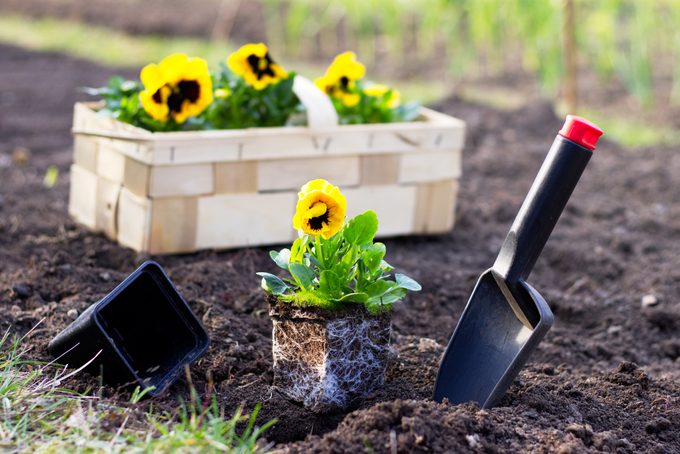

I like to bookend my gardening year with pansies. In early spring, the owner of my local retail greenhouse texts me to lets me know the pansies are beginning to flower and ready for planting. So I drop what I’m doing and head over to buy pansies and violas to start my gardening year. Repeat in the fall!
On This Page
What Is a Pansy?
Pansies are short-lived perennials in the violet family.
Beginning in the late 1700s, European botanists and gardeners began to crossbreed several types of violas to produce bigger flowers. They ended up with the hybrid flower, Viola x wittrockiana, the pansy we have today.
Plant breeders have given us pansies in nearly every color, some with markings that give the blooms the appearance of a face.
Pansies like it cool. Gardeners in U.S. Department of Agriculture Plant Hardiness Zones 4 through 8 generally plant them in early spring or late fall. They’ll do well with surprisingly chilly temperatures but almost seem to melt in the heat. In Zones 9 through 11, pansies are often planted as a winter-flowering annual.
What’s the Difference Between a Pansy and a Viola?
Often when you see pansies for sale, you’ll find a similar plant with a smaller pansy-type flower next to them. These plants aren’t just a smaller pansy; they’re a different species, Viola cornuta, in the same family.
Violas also tend to be shorter. They’ll often be more tolerant of hotter weather, although neither pansies nor violas will keep flowering in the heat of summer.
Types of Pansies
Most of us will buy whatever type of pansy we see at our local garden center. But it’s worth looking for specific varieties for particular growth habits or colors.
- Cool Wave pansies were bred to produce flowers on plants that spread out more than up. They’re a good choice for hanging baskets or containers where they can spill over the sides.
- ‘Antique Shades’ or ‘Moulin Rouge‘ pansies have ruffled petals and muted colors, giving them an old-fashioned look.
- For soft shades of pinks and blues — perfect for springtime — look for ‘Cotton Candy’ mixed pansies.
- For darker fall colors, ‘Atlas Mix‘ includes almost black flowers as well as orange and yellow blooms.
How To Plant Pansies

Most gardeners purchase pansies as small plants, but they can also be grown from seed.
Planting in containers
Pansies do well in containers as annuals. They can be potted in the spring, well before your last frost of the year, because they tolerate lower temperatures. You can also plant them in the fall as temperatures cool. They’ll continue to grow even after the first frosts.
Fill a container with potting soil and space pansies at least six inches apart to give them room to grow. (Be sure the pot has drainage holes.) In the spring, the container can be in full sun.
As the days get warmer and brighter, you may need to move the pansies out of full sun during the hottest part of the day, but they still need some sun. In the shade, pansies become leggy, stretching to try to get some light.
Planting in-ground
To grow pansies in the ground, choose a location with good, well-draining soil and some sun. Plant as soon as you can work the soil in the spring, or later in the fall once days and nights begin to cool.
Growing from seed
To get a specific variety of pansy, you may need to grow your own from seed.
Sow pansy seeds indoors about 10 weeks before you plan to plant them outside. In the spring, this often means early January. For fall planting, start your seeds by mid-summer. Seeds should be kept in the dark until they germinate, then placed under grow lights.
Before planting the seedlings, place them outside in a protected spot for a few hours a day.
How To Care for Pansies
Pansies are technically short-lived perennials, but most of us grow them as annuals. Here are a few tips for keeping your pansies looking fresh until it gets hot.
Watering
Keep pansies watered enough so they don’t wilt. As they grow, they may not need to be watered as frequently. In the fall, avoid overwatering or putting too much mulch around them. Wet soil can cause root rot.
Fertilizer
When growing pansies in containers, occasionally add a fertilizer labeled for flowers. In the ground, if you have good soil, they probably don’t need any.
Pruning
To encourage growth and more blooms, remove faded flowers and dead foliage by cutting or pinching them off.
Overwintering
Pansies may survive the winter in milder climates, and even in colder climates if they’re protected. But in my experience overwintered pansies look a little rough by spring, so I usually start over with new pansies.
Did you miss our previous article…
https://tophouseimprovement.com/how-to/black-friday-2022-refrigerators-sales-a-kitchen-refresh/
